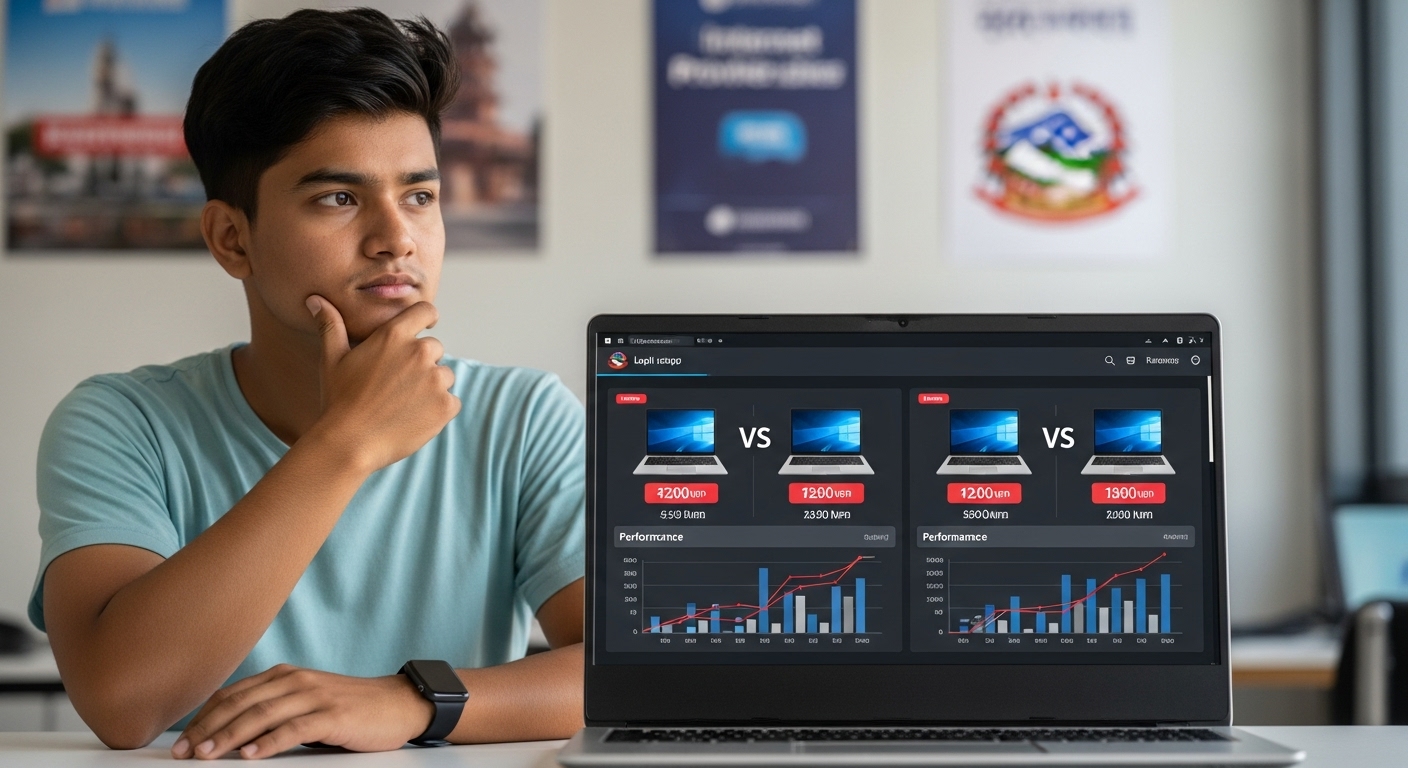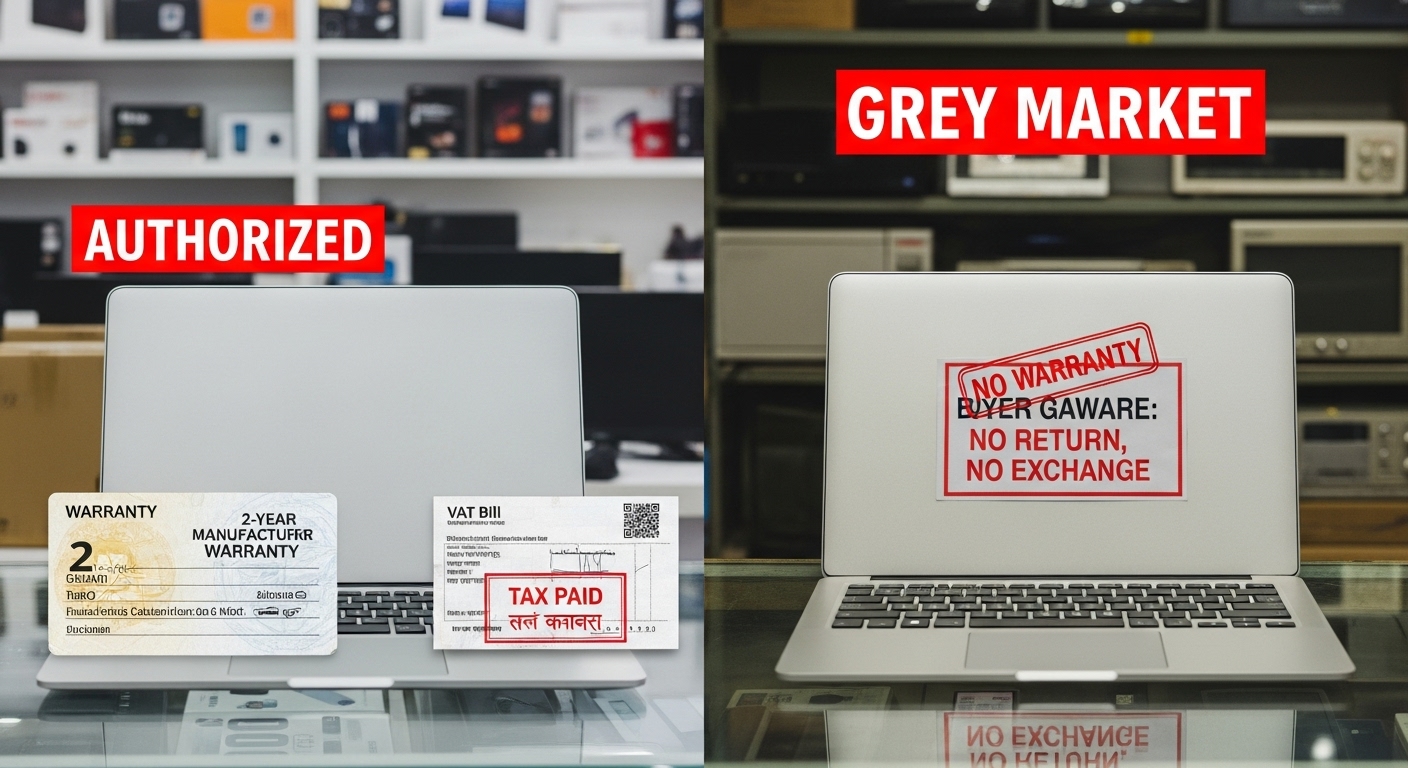Best Budget Laptops for Nepali Students: Buyer’s Guide
Executive Summary
The Nepali laptop market presents a complex landscape for students seeking a device that balances performance and cost. A thorough analysis reveals that the concept of a “budget” laptop is highly relative, depending on a student’s field of study and the crucial factor of after-sales support. The market is dominated by a few key players—Dell, Lenovo, and Acer—each carving out a niche based on reliability, durability, or value for money.
A significant market dynamic is the prevalence of “grey market” imports, which, while superficially cheaper, pose a substantial risk to the buyer. These laptops often lack an official warranty, making them ineligible for local service centers and potentially turning a minor repair into a total loss of investment. Therefore, the single most critical piece of advice for any buyer is to purchase from an authorized dealer and always demand a VAT bill and an official warranty card to ensure long-term security.
For the average student, the Mid-Range Sweet Spot of NPR 60,000 to NPR 85,000 offers the best value, providing a blend of modern specifications and a reliable user experience. Top recommendations in this category include the Lenovo IdeaPad Slim 3, known for its strong performance; the Acer Aspire Go/Lite series, recognized for exceptional value; and the Dell Vostro/Inspiron series, praised for its trusted reliability. A successful purchasing decision in Nepal is not just about the initial price tag; it’s a holistic assessment of specifications, brand reputation, and the assurance of a genuine warranty.

Chapter 1: The Student Laptop Market in Nepal: An In-Depth Analysis
1.1. Dominant Brands and Market Dynamics
The laptop market in Nepal is a highly competitive arena, with a handful of brands consistently leading in popularity and consumer trust. Dell, in particular, has cemented its position as the most searched and trusted brand, largely attributed to its wide range of laptops that cater to diverse budgets and needs. This brand’s success is not just a matter of price but is fundamentally rooted in its reputation for unmatched reliability and durable designs. For a consumer in a market where sourcing and authenticity can be uncertain, a brand’s proven track record of dependability acts as a powerful proxy for true value. A potential buyer’s willingness to pay a certain price is heavily influenced by this perceived trustworthiness, which often makes a Dell laptop a more compelling option even if a competitor offers a slightly better on-paper specification at the same cost.
Alongside Dell, other brands have established strong footholds. Lenovo has made a significant mark, especially among students and professionals, due to its durable build quality and efficient performance. Its popular IdeaPad series is a testament to this, frequently recommended as a go-to choice for students. Acer has gained a strong position by focusing on the budget-conscious consumer, offering high-quality laptops at affordable prices. The brand is known for delivering exceptional value for money, with its Aspire series being particularly popular for reliable, everyday use. HP also remains a consistently searched and trusted brand, known for its innovative features and reliable performance across various user segments. Other notable brands include Asus, preferred by gamers and creators, and Apple, which, despite its premium pricing, is a strong contender known for its performance and sleek design, especially among creatives and professionals.
1.2. The Price-to-Performance Spectrum: Demystifying “Budget”
The term “budget laptop” in the Nepali context is highly fluid, as the market offers devices ranging from a basic Rs 15,000 to a premium Rs 250,000 and beyond. To provide a more useful framework, the market can be segmented into distinct price tiers based on a student’s typical needs and what is realistically available.
The Ultra-Budget Tier (Under NPR 60,000) is for students with very basic computing needs, such as web browsing, document editing, and online classes. Devices in this category, like the Dell Wyse 5470 (at approximately Rs 44,000) or the Lenovo V15 G4 (starting at Rs 52,499), typically feature entry-level processors and sufficient, but not expansive, RAM and storage. While highly affordable, these laptops may not be suitable for demanding tasks or offer a future-proof experience.
The Mid-Range Sweet Spot (NPR 60,000 – NPR 85,000) is where the best value for the average student lies. This range provides a significant leap in performance and features without a disproportionately high increase in cost. Models like the Lenovo V14 G4 (around Rs 68,000) and the Dell Vostro 3530 (starting from Rs 72,000) are prime examples. These devices often come with a modern Intel Core i5 or AMD Ryzen 5 processor, 8-16GB of RAM, and a fast 512GB SSD, making them ideal for everyday academic and multitasking needs.
Finally, the Performance-Budget Segment (NPR 85,000 – NPR 100,000) caters to students who need a bit more power for specific applications, such as light coding or design work. This category includes more powerful mainstream laptops and even some entry-level gaming devices. The Acer Aspire Go 14 AI PC (priced at Rs 92,000) and the Acer Nitro V 15 (at Rs 95,999) are excellent examples, offering newer processors and potentially dedicated graphics for a smoother experience with more intensive tasks.
1.3. Navigating the Market: The Authorized vs. Grey Market Dilemma
A critical factor for any laptop buyer in Nepal is understanding the distinction between officially distributed laptops and those from the “grey market.” According to industry experts, grey market laptops are imported through unauthorized channels, often without paying customs duties. This allows sellers to offer them at a price that can be 10-15% lower than their officially distributed counterparts, which can be highly enticing for budget-conscious students.
However, this price advantage comes with significant and often costly risks. The core problem is the lack of a valid, official warranty. These devices are not intended for the Nepali market, meaning local service centers will not honor the manufacturer’s warranty. A buyer might save a few thousand rupees upfront, only to find themselves with a device that is ineligible for repairs if it fails shortly after purchase. The true cost of a grey market laptop is not its purchase price, but the potential for a complete loss of the investment in the event of a hardware failure.
To safeguard against this, buyers must be vigilant. The research emphasizes a set of essential precautions: always demand a VAT bill and a brand-authorized warranty card. A genuine laptop will come in a sealed, branded box with matching serial numbers on both the device and the packaging, which can be verified on the manufacturer’s official website. Additionally, buyers should check the laptop’s physical condition for any signs of wear and tear, and verify that the pre-installed operating system is genuine and not tampered with. The choice a student makes in this context is not merely a financial decision but a risk-assessment. The desire for a low price can lead to a financially unsound decision in the long run.

Chapter 2: Essential Specifications for the Modern Student
2.1. Core Components Explained: Processor, RAM, and Storage
For a student laptop, the interplay of the processor, RAM, and storage dictates its overall performance and longevity. These three components are the foundational pillars of a device’s capability, and understanding their roles is crucial for making an informed purchase decision.
The Processor (CPU): This is the brain of the laptop, responsible for executing all commands. For general student use—which involves tasks like web browsing, document creation, and multimedia consumption—an Intel Core i5 or an equivalent AMD Ryzen processor is the recommended minimum. For those in more demanding fields, an Intel Core i7/i9 or AMD Ryzen 7/9 is preferred to handle resource-intensive applications without performance lag.
Random Access Memory (RAM): RAM is the short-term memory of the computer, allowing it to run multiple applications and process data quickly. The research indicates that 8GB of RAM is the absolute minimum for basic functionality, but multitasking can lead to performance dips. For a smoother and more responsive experience, especially for students who work with multiple browser tabs or applications simultaneously, 16GB of RAM is strongly recommended. For creative or engineering students using software like AutoCAD or for video production, 32GB is considered ideal for intensive workloads.
Storage: The type and capacity of storage directly impact a laptop’s speed and ability to hold files. Solid-state drives (SSDs) are now the standard for student laptops, as they are significantly faster and more durable than traditional hard disk drives (HDDs). A minimum of a 500GB SSD is advised for adequate flexibility, while a 1TB SSD or larger is recommended for students handling large projects, creative software, or extensive media files.
2.2. Tailored Recommendations by Field of Study
The term “budget” is entirely dependent on a student’s academic discipline. A laptop that is perfectly sufficient for a general studies student may be completely inadequate for an engineering student. This analysis segments recommendations to align with specific academic requirements.
For General Studies and Humanities: A student in these fields primarily needs a device for research, writing, presentations, and online collaboration.
The focus should be on portability, a comfortable keyboard, and long battery life.
- Target Specs: Intel Core i3 or i5, 8GB RAM, 256GB to 512GB SSD.
- Target Price Tier: Ultra-Budget to Mid-Range Sweet Spot (Under NPR 85,000).
For Computer Science and IT
Programming and IT-related courses require more processing power for compiling code, running virtual machines, and managing multiple applications simultaneously. The processor and RAM are the most critical components for these tasks.
- Target Specs: A modern Intel Core i5 (H-series processor preferred for higher performance) or AMD Ryzen 5, 16GB of RAM, and a 512GB SSD.
- Target Price Tier: Mid-Range Sweet Spot to Performance-Budget (NPR 60,000 – NPR 100,000).
For Engineering, Architecture, and Design
The software used in these fields, such as CAD, 3D modeling, and video editing, is highly demanding and requires a dedicated graphics card. The “budget” for these students is in a different league entirely.
- Target Specs: A high-performance processor (Intel Core i7/i9 or AMD Ryzen 7/9), 16GB to 32GB of RAM, at least a 1TB SSD, and a dedicated GPU (e.g., NVIDIA GeForce RTX 3050/4050).
- Target Price Tier: This segment requires a significant investment, with prices typically starting well above NPR 100,000.
Chapter 3: Comparative Analysis of Top Budget Laptops
This section provides a detailed look at the leading laptop models available in Nepal for students within the most practical price brackets.
3.1. The Ultra-Budget Category (Under NPR 60,000)
Laptops in this category are designed for the most basic of tasks and prioritize affordability above all else. A prime example is the Dell Wyse 5470, a very low-cost option priced at around Rs 44,000, featuring an Intel Celeron processor, 8GB of RAM, and a 256GB SSD. Another notable option is the Acer Aspire Go 15, which offers an Intel Core i3 processor, 8GB of RAM, and a 256GB SSD for approximately Rs 49,499. While these devices are accessible, their limited specifications mean they are not well-suited for multitasking or for students whose academic demands may grow over time.
3.2. The Mid-Range Sweet Spot (NPR 60,000 – NPR 85,000)
This price bracket represents the optimal balance of cost and capability for the majority of students. The following table provides a clear comparison of the top contenders.
| Model | Processor | RAM | Storage | Display | Price Range (NPR) | Best For |
|---|---|---|---|---|---|---|
| Lenovo V14 G4 | AMD Ryzen 5 7520U | 16GB | 512GB SSD | 14″ FHD | 68,000 | All-around reliability & everyday tasks |
| Acer Aspire Lite 16 | Intel Core i5 13th Gen 1334U | 16GB | 512GB SSD | 16″ FHD WUXGA IPS | 71,999 | Multitasking & screen real estate |
| Dell Vostro 3530 | Intel Core i5 13th Gen | 16GB | 512GB SSD | 15.6″ FHD 120Hz IPS | 72,000-74,499 | Dependable performance & business-grade build |
| Lenovo IdeaPad Slim 3i | Intel Core i5 13th Gen 13420H | 8-16GB | 512GB SSD | 14-15.6″ FHD | 73,999-82,999 | Powerful processor for its price tier |
| ASUS Vivobook Go E1404 | AMD Ryzen 5 7520 | 8GB | 512GB SSD | 14″ FHD | 76,000 | Portability & aesthetics |
The data reveals that within this segment, there is some variability in price and specifications for a given model. For instance, the Dell Vostro 3530 is listed at Rs 73,999 by one retailer but at Rs 72,000 by another, depending on the exact configuration and any ongoing promotions. This is a common characteristic of the market, making it important for buyers to compare prices across different authorized retailers like ITTI Computer World and ONIN Infosys.
Chapter 4: Detailed Model Profiles & Justification
4.1. Top Pick: Lenovo IdeaPad Slim 3
The Lenovo IdeaPad Slim 3 stands out as a top recommendation for its ideal balance of performance and affordability. As a member of the popular IdeaPad series, it inherits a reputation for durable build quality that appeals to students and professionals alike. Specifically, the 2025 model with the Intel Core i5-13420H processor offers a level of performance that is arguably the best under Rs 80,000 in Nepal. The processor’s H-series designation signifies a higher performance tier, which is excellent for coding or other multitasking academic work. Paired with 16GB of DDR5 RAM and a 512GB SSD, this device is not only capable of handling current academic workloads but is also well-positioned to remain relevant for years to come.
4.2. Best Value: Acer Aspire Go/Lite Series
Acer has built its brand on delivering exceptional value, and the Aspire Go and Aspire Lite series are prime examples of this strategy. The Acer Aspire Go 14 AI PC, for instance, offers a modern 14th Gen Intel Core Ultra 5 processor and 16GB of RAM for around Rs 92,000. This laptop provides a powerful and future-proof experience, including AI-powered features, at a competitive price. The Acer Aspire Lite 16, a model from a similar lineage, offers a 13th Gen Intel Core i5 and 16GB of RAM for under Rs 72,000. These laptops exemplify Acer’s commitment to providing strong specifications at a price point that makes them highly accessible to budget-conscious students, solidifying the brand’s position as a reliable choice for value-oriented buyers.
4.3. Reliable Workhorse: Dell Vostro/Inspiron Series
Dell’s brand dominance is largely due to its reputation for producing trusted and reliable devices. The Vostro and Inspiron series cater directly to the student and professional market, offering a no-frills, dependable experience. A Dell Vostro 3530 with a 13th Gen Intel Core i5, 16GB of RAM, and a 512GB SSD is a workhorse capable of handling multitasking and general academic work with ease. This series is often recommended for its durable design and solid performance, making it a safe and long-lasting investment for students who prioritize stability and brand trust over the latest flashy features.
4.4. The Premium Contender: A Look at the MacBook Air M1
While not a conventional “budget” laptop in terms of its initial price, the Apple MacBook Air M1 is considered a “budget ultrabook” in the Nepali market and merits a discussion. Priced around Rs 101,000, it is a significant upfront investment, but its value proposition is different. The M1 chip was a game-changer, offering fanless, silent performance and a remarkably long battery life of over 15 hours of real-world use. For a student who can afford this initial cost, the MacBook Air M1 represents a long-term investment in a highly efficient, reliable, and portable device. Its seamless integration with the macOS ecosystem makes it a popular choice for creative students, though those with specific software requirements (like engineering or design) should be aware that some applications may not run natively.
Chapter 5: After-Sales Support: The Hidden Cost of Ownership
5.1. The Importance of a Local Warranty
A laptop purchase is a significant investment in Nepal, with entry-level prices starting around NPR 45,000. This is why the importance of a valid warranty cannot be overstated. A laptop purchased from the grey market, even if it is a genuine brand, lacks a manufacturer’s warranty and is often not recognized by official local service centers. This is a critical risk, as a minor hardware failure, such as a faulty motherboard or a broken screen, can result in the entire device being rendered unusable with no recourse for repair or replacement. The long-term financial risk of buying a grey market product outweighs any marginal savings on the initial purchase price.
5.2. A Guide to Authorized Service Centers in Nepal
In a market where brand-specific support can be fragmented, understanding the local after-sales landscape is crucial. Major brands like Dell, Lenovo, and HP have established or authorized service partners in Nepal. Dell offers international travel support, and customers can find assistance online or via phone by entering their service tag on the global support website, though support is subject to the availability of local parts. Asus has a unique “Perfect Warranty” policy for its brand new products sold through authorized resellers in Nepal. This program requires the buyer to register the product within 90 days of purchase and covers 80% of the repair cost for a single claim within the first year. This kind of policy provides a unique and powerful layer of protection against accidental damage. Additionally, a robust ecosystem of third-party repair hubs like Nepal Tech and Guru Computer Solution exists in Kathmandu. These centers advertise services for multiple major brands, including Lenovo and HP, and claim to use genuine parts and offer services ranging from screen repair to motherboard replacement and RAM upgrades. This local ecosystem provides an extra layer of comfort for consumers, knowing that even if they are out of warranty, repair options are available, though it is always best to prioritize official channels when possible.
5.3. After-Sales & Warranty Comparison for Major Brands
The following table provides a synthesis of the after-sales policies and support available for major laptop brands in Nepal, highlighting the nuances that can influence a long-term purchasing decision.
| Brand | Standard Warranty Length | Key Policy Highlights | Local Support | Buyer’s Note |
|---|---|---|---|---|
| Dell | Varies, typically 1 year. |
- Some batteries may have a 3-year option.
- International travel support is available for less than six months of travel, subject to local parts availability.
- Official online/phone support is available, and authorized repair centers exist in Kathmandu.
- The brand’s reputation for reliability is a key factor, making the standard warranty a strong point of reassurance.
Lenovo
- Varies, typically 1 year.
- Warranty is generally honored through official and authorized channels.
- Dedicated repair centers in Kathmandu, such as Nepal Tech, advertise services with certified technicians and genuine parts.
- Known for durable designs, which can reduce the need for warranty claims.
HP
- Varies, typically 1 year.
- Official warranty services are reliable through authorized channels.
- Local service centers, like Guru Computer Solution and Nepal Tech, are widely available in Kathmandu for repairs and part replacements.
- A trusted brand with a strong presence, providing a sense of security for buyers.
Asus
- Varies. One-year official warranty.
- Offers a unique “Perfect Warranty” which covers 80% of the repair cost for one claim within the first year of ownership after product registration.
- Support available via official website and local service centers.
- The accidental damage coverage through its Perfect Warranty is a significant differentiator that directly mitigates the risk of costly mishaps.
The variability in these policies, particularly the added benefits offered by a brand like Asus, shows that after-sales support is not a uniform “yes or no” feature. It is a critical component of brand value and a key consideration for a buyer concerned about the total cost of ownership.
Conclusion & Final Recommendations
Navigating the laptop market in Nepal requires a comprehensive approach that extends beyond merely comparing specifications and prices. The dual-market economy, with its authorized and grey market channels, presents a core challenge for students seeking a budget-friendly device. The analysis of brand dominance, price segmentation, and after-sales support reveals that a truly smart purchase decision is a holistic one.
For the average student, the definitive recommendation is to aim for a laptop within the Mid-Range Sweet Spot of NPR 60,000 to NPR 85,000. This segment offers a proven track record of dependability from top brands like Dell, Lenovo, and Acer, providing modern specifications that are more than sufficient for general academic use. For students in specialized fields like engineering or design, the “budget” tier is redefined and necessitates a higher upfront investment in a device with a dedicated GPU and more RAM to support demanding software.
The single most crucial piece of actionable advice for any buyer in Nepal is to always insist on a VAT bill and an official warranty card from an authorized retailer. This action is the only definitive way to ensure the laptop is a genuine, officially supported product. This small but critical step safeguards the entire investment, providing access to long-term after-sales support and mitigating the significant financial risk associated with grey market imports. Ultimately, the best budget laptop for a student in Nepal is not the cheapest option, but the one that offers the most value, reliability, and security over its entire lifecycle.


